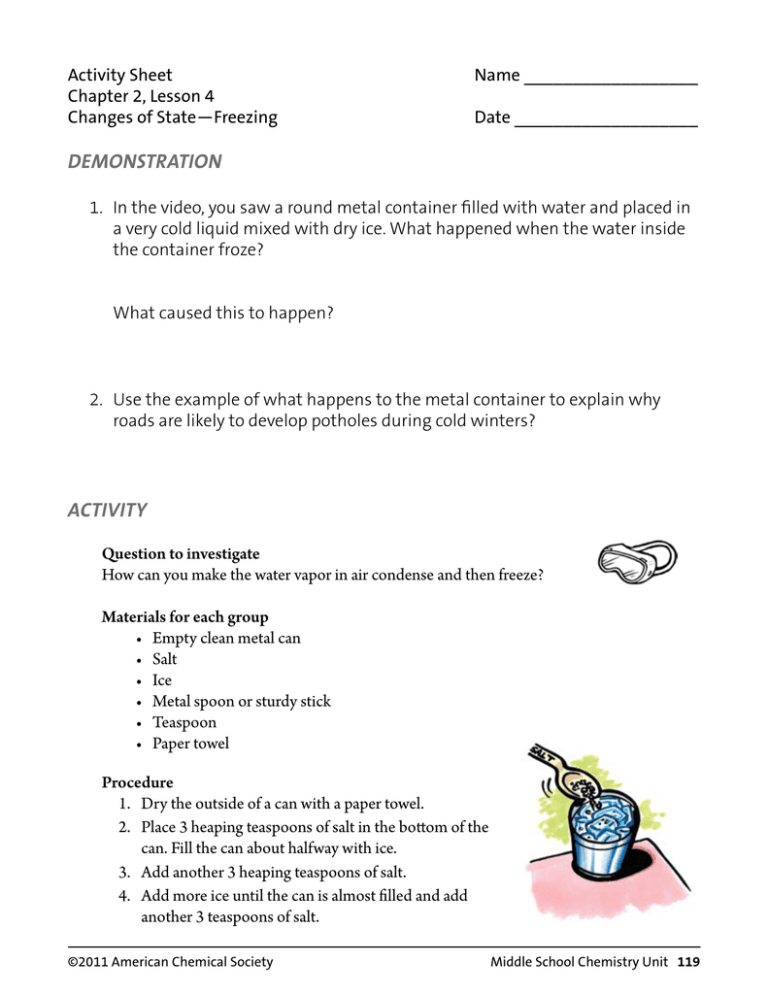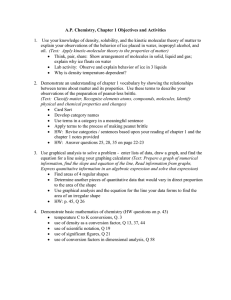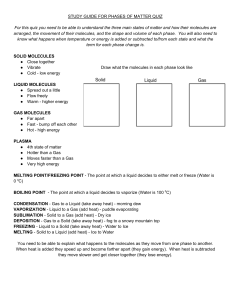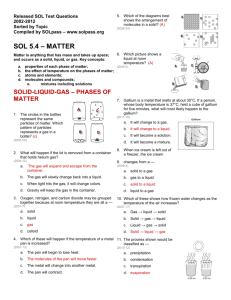Activity Sheet Name __________________ Chapter 2, Lesson 4
advertisement

Activity Sheet Chapter 2, Lesson 4 Changes of State—Freezing Name __________________ Date ___________________ DEMONSTRATION 1. In the video, you saw a round metal container filled with water and placed in a very cold liquid mixed with dry ice. What happened when the water inside the container froze? What caused this to happen? 2. Use the example of what happens to the metal container to explain why roads are likely to develop potholes during cold winters? ACTIVITY Question to investigate How can you make the water vapor in air condense and then freeze? Materials for each group • Empty clean metal can • Salt • Ice • Metal spoon or sturdy stick • Teaspoon • Paper towel Procedure 1. Dry the outside of a can with a paper towel. 2. Place 3 heaping teaspoons of salt in the bottom of the can. Fill the can about halfway with ice. 3. Add another 3 heaping teaspoons of salt. 4. Add more ice until the can is almost filled and add another 3 teaspoons of salt. ©2011 American Chemical Society Middle School Chemistry Unit 119 5. Hold the can securely and mix the ice-salt mixture with a metal spoon or sturdy stick for about 1 minute. Remove the spoon, and observe the outside of the can. Do not touch it yet. 6. Wait 3–5 minutes. Watch the animations while you wait. EXPLAIN IT WITH ATOMS & MOLECULES 3. Look at and touch the outside of the can. What do you observe? 4. Describe what happened to the water vapor in the air when it came in contact with the cold surface of the can. Be sure to mention how the molecules change speed and how they are attracted to each other. 5. Your can might have some water and some ice on the outside of it. Explain how this can be possible. 6. You have seen molecular model animations of water and ice. Fill out the chart to compare how the molecules move in water and ice. Select one of the options in each row and write it under “water” or “ice” in the chart. 120 Middle School Chemistry Unit ©2011 American Chemical Society Compare molecules in water and ice Water Ice Speed of molecules faster slower Amount of movement remain in fixed positions move past each other Arrangement of molecules very organized random and unorganized Distance between molecules closer together slightly further apart 7. Write captions under the pictures to explain how the movement and position of molecules changes as the water freezes to become ice. ©2011 American Chemical Society Middle School Chemistry Unit 121 8. The temperature at which a substance freezes is called the freezing point. Different liquids have different freezing points. Here are a few examples. Water Corn oil Isopropyl alcohol 0 °C about –20 °C –88.5 °C Why do you think different liquids have different freezing points? 9. Nitrogen is a gas at room temperature. It needs to be cooled to –196 °C to condense to a liquid and freezes at –210 °C. Do you think the attractions between nitrogen molecules are strong or weak? Why? TAKE IT FURTHER 10. Freezing is the process that occurs when a liquid changes to a solid. Frost forms through a process called deposition. What happens during the process of deposition? 122 Middle School Chemistry Unit ©2011 American Chemical Society






